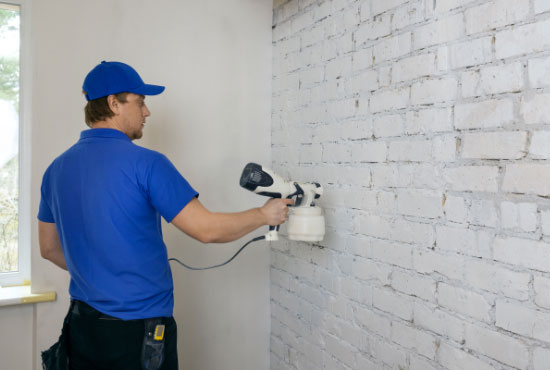There are a lot of people who have asked us how to spray paint interior walls and ceilings. The affordability of the paint spraying equipment and the amount of time that people can save by using this equipment instead of the traditional roller and brush has made this a very popular question.
We are not novices when it comes to interior painting, but we still reach out to professional painters and renovation experts to get the most useful advice on this subject. We must admit that we learned quite a few things that we intend to use the next time we start painting our own homes and offices.
Get the Right Sprayers for Walls and Ceilings
There are basically two varieties of paint sprayers, but there are many features that these sprayers can have that will make your job easier to do. Make sure you get the right sprayer with the right features.
Air-Driven Sprayers
These sprayers require you to connect an air compressor to them. Air compressors can be costly, bulky, and loud. They are not something you want to have to run inside a house while you are painting.
Air-less sprayers do not require an external air compressor. These sprayers do cost more initially than the air-driven variety but you do not have to buy an air compressor to operate them so the additional cost should not be a consideration.
These units may be powered by gas or electricity. They are easy to use, easy to clean, and store. They are less noisy, and they are readily available at most hardware and tool supply centers.
Air-less Sprayers Features to look for
Paint capacity
The sprayers do not all hold the same amount of paint. You want a sprayer that can hold a good amount of paint so you do not have to stop as often to fill the holding container with more paint.
If you can get a sprayer that picks the paint up directly from the paint container then you do not have to worry about filling a paint container or running out of paint right in the middle of a section.
Adjustable Pressure Controls
Being able to adjust the pressure on the sprayer lets you control how much paint is sprayed at one time and how much overspray you might have. This feature also allows you to work with different paint thicknesses.
Paint Thickness
Sprayers typically require you to thin the paint before it can be sprayed. However, there are sprayers who are capable of spraying the thicker paints without any thinning.
If you thin the paint then you have to make more coats in order to achieve the proper wall coverage.
Wheels
Some sprayers are quite heavy. You want to make sure you get a spraying unit that has wheels on the heavy part so you do not have to lift it repeatedly.
Hose Length
The length of the air hose is going to limit how far away from the main spraying unit you can walk before moving the unit. A longer air hose might allow you to leave the main section in one place and not move it at all.
Tips for Spray Painting Walls and Ceilings
Essential Painting Tools and Equipment
You cannot start a painting project without assembling all of the necessary tools and supplies. You do not want to have to stop what you are doing, wash all of the equipment, and halt the progress to run to town and buy something you forgot.
- Air sprayer
- Clean cloths
- Paint brush (yep you still need one)
- Painters’ tape
- Plastic, cardboard, or newspaper to cover large items like window glass
- Screwdrivers (Go ahead and bring a flat tip and Phillip’s head)
- Primer
- Paint
- Empty bucket
- Extra cardboard
- Respirator or mouth covering
- Goggles or eye protection
- Plastic exam gloves
Prepare The Room
Step 1: The first thing you do is prepare the room. You either have to move all of the large pieces of furniture to the middle of the room and cover them with plastic to protect them or move the pieces to another room so you can move around the room freely.
Step 2: You need to remove all switch plate covers and outlet covers. Be sure that you tape the screws that go to the individual cover to the back of that cover so you do not lose it. Those screws are important. You can also remove the cover and simply place the screw in the screw-hole until the job is finished.
Step 3: Tape painters’ tape over the face of the outlets and switches so paint does not get on them.
Step 4: Remove any nails, brackets, or screws that are in the wall where you have been hanging pictures, televisions, shelves, and such.
Step 5: Remove doorknobs, hinges, and hardware like this. If you cannot remove the hardware tape it with painters’ tape to protect it.
Step 6: Cover windows with plastic and tape the plastic in place. You can also cover the doors with plastic if you do not want the paint to get on them.
Step 7: Remove the baseboards and wooden trim to keep the paint from getting on them unless you plan to paint them. If you cannot remove them you can cover them with painter’s tape.
Step 8: Cover the floor so you do not get paint on the floor.
Read More>> How to Spray Paint Wood Furniture
Prime the Ceiling and Walls
You are going to use the same color primer on both the ceilings and the walls so it makes sense to go ahead and prime everything at one time.
Make sure the surfaces are free of dirt, dust, and grime so the paint can adhere more completely. Allow the primer to totally cure before you start applying the paint.
How to Spray Paint Ceiling
Before you start painting a room with a brush and roller you have to cut the paint in around the edge of the room. This is not always necessary when you are using a sprayer.
You need to protect your eyes and cover your nose and mouth to keep paint from getting into them.
Always test the spray tip you have chosen by making a spray onto cardboard. This test spray will let you see if the paint is a perfect consistency and if the pattern the tip sprays is right for what you are doing.
You want to hold the tip of the sprayer between 6 and 12 inches away from the surface. The most desirable method is to make a full sweep of the room with each spray. So if you start on the right side paint all the way over to the wall on the left side before you start another sweep.
You have to overlap the paint to create complete coverage so when you start the next sweep overlap the first row by about 15% to make sure you have complete coverage.
If you are on a ladder then you are going to have to work your ceiling in sections spraying what you can reach easily before having to get down and move the ladder. Try to feather the spray out at the end of a section so you do not create visible lines on the ceiling.
How to Spray Paint Your Interior Walls

You really need to take the time and either cover the area around the edge of the ceiling with painter’s tape or use a brush and cut in the paint around the top of the wall so you do not have to get the sprayer as close to the ceiling.
Once you have tested your tip and paint consistency you want to spray the paint from the top down to the bottom of the wall in one strip at a time. Once you have painted all the way to the floor then you start at the top again, overlapping the paint strip so you get complete coverage.
Do not try to apply a second coat of paint before the first coat is completely dry. If you can touch the wall lightly without getting paint on your hand the paint is said to be “dry to the touch” but that does not mean ready to accept another coat. Before the paint is ready for a second coat you must be able to press your hand against the area and have no transfer and the paint must not feel tacky or sticky to the touch.
Read Also>> How to Fix Painting Mistakes on Walls
Tips from the Pros
- Proper cleanup is a must. You have to clean your equipment at the end of each day to keep it from gumming up. This is not an option.
- When thinning paint if you thin it more than 20% you may cause the paint to drip or run easily.
- If you notice that you have a low spray volume or you see chunks of paint then you need to thin the paint a little.
- Wearing goggles and face coverings protect you while you paint but consider wearing a shower cap and protecting your hair from overspray and such.
- Quality paint is recommended, and if you are going to be using more than one container of the same color of paint mix the two paints together before you start. There can be variations between two containers of paint even though they are from the same manufacturer and they are supposed to be the same color. You might not even notice the variation until the paint is dry. If you have two or more containers of the same paint mix them together and you will get one paint that is a uniform color and all of your walls will look the same.
Frequently Asked Questions
Do you spray paint walls or ceilings first?
You want to paint the ceiling of the room before you paint the walls. Paint from the top of the room to the bottom of the room to eliminate mistakes and runs from forming down a freshly painted area.
What is the best sprayer for spray painting indoors?
An airless paint sprayer is an ideal choice for interior painting projects. They eliminate the need for the external air compressor so they are less noisy and easier to maneuver around the room.
Is it better to roll or spray interior paint?
When you spray the paint on you can get thinner coats that dry quickly. The coverage is often smoother in appearance, and if you are painting a textured surface the paint can get onto every portion of the texture to create uniform coverage. Spraying uses more paint and may require more preparation than rolling does.
Final Thoughts
The air-less sprayers are making the job of painting your home easier to do. More and more homeowners are opting to paint their rooms instead of hiring professional painters to do the work.
The main key to doing this work and getting the results you like is to take your time, plan ahead so you have all of the supplies you need, and let everything dry completely before reapplying or moving furniture back against the surfaces.
